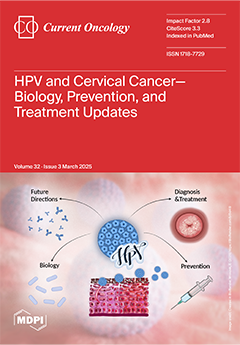Introduction: Endometrial cancer (EC) is one of the most common gynecologic cancers, with an increasing incidence due to variables such as aging and lifestyle changes. Current biomarkers exhibit limited prognostic value, despite advancements in understanding their molecular basis, underscoring the necessity for new
[...] Read more.
Introduction: Endometrial cancer (EC) is one of the most common gynecologic cancers, with an increasing incidence due to variables such as aging and lifestyle changes. Current biomarkers exhibit limited prognostic value, despite advancements in understanding their molecular basis, underscoring the necessity for new molecular markers. Microtubule affinity-regulating kinase 3 (MARK3) has been identified as a potential candidate owing to its established prognostic significance in various cancers; however, its function in endometrial cancer (EC) is not yet well understood.
Methods: This study investigates the function of MARK3 in endometrial cancer through the analysis of Ishikawa and HEC-1B cell lines. A series of assays were conducted, including colony formation, CCK-8 viability, EDU proliferation assays, scratch wound healing tests, and Transwell migration assays, to investigate the effects of MARK3 overexpression. We conducted RT-qPCR, Western blot, and immunofluorescence assays to evaluate the molecular mechanisms influencing cell proliferation and migration. Bioinformatics analysis utilized publicly available datasets to examine the gene enrichment and co-expression networks.
Results: The overexpression of MARK3 markedly reduced colony formation in both Ishikawa (
p = 0.0039) and HEC-1B (
p = 0.0014) cell lines. Furthermore, the overexpression of MARK3 led to decreased cell viability, as demonstrated by the EDU assay results (Ishikawa-OE
p = 0.0302; HEC-OE
p = 0.0037). The molecular analysis supported these findings, indicating an increase in phosphorylated AKT (pAKT), thereby suggesting MARK3’s role in regulating cell survival pathways. Gene enrichment analysis revealed pathways associated with cell cycle regulation and apoptosis, whereas co-expression analysis pinpointed critical interacting genes that may play a role in EC progression.
Conclusions: MARK3 is essential in the regulation of cell proliferation and migration in endometrial cancer, positioning it as a potential prognostic biomarker and therapeutic target. This study represents the inaugural investigation into the functional role of MARK3 in endothelial cell progression, thereby enhancing our comprehension of its mechanistic influence on cancer biology and its implications for personalized therapy. Bioinformatics analysis reinforces the relevance of MARK3 in endometrial cancer, offering new insights into its clinical significance.
Full article






